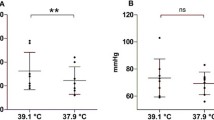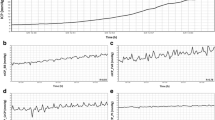Abstract
Objective
To evaluate an intraparenchymal probe for intracranial pressure (ICP) and temperature (TEMP) monitoring as well as determination of cerebral hemodynamics using a near-infrared spectroscopy (NIRS) and indocyanine green (ICG) dye dilution method (NIRS-ICP probe).
Methods
The NIRS-ICP probe was applied after aneurysmal subarachnoid hemorrhage if multimodal monitoring was established due to poor neurological condition. ICP and TEMP values were obtained from ventricular catheters and systemic temperature sensors. Repeated NIRS-ICG measurements (2 injections within 30 min) were performed daily for determination of cerebral blood flow (CBF), cerebral blood volume (CBV), and mean transit time of ICG (mttICG). Secondary neurologic dysfunction was defined as brain tissue oxygen tension <20 mmHg and/or lactate/pyruvate ratio >35 obtained from cerebral probing.
Results
A total of 128 NIRS-ICG measurements were performed in ten patients. The correlation coefficients between ICP and TEMP values obtained with the NIRS-ICP probe and values from routine monitoring were r = 0.72 and r = 0.96, respectively. The mean values were 30.3 ± 13.6 ml/100 g/min for CBF, 3.3 ± 1.2 ml/100 g for CBV, and 6.8 ± 1.6 s for mttICG. The coefficients of variation from repeated NIRS-ICG measurements were 10.9 % for CBF, 11.7 % for CBV, and 3.8 % for mttICG. The sensitivity for detection of secondary neurologic dysfunction was 85 % and the specificity 83 % using a CBF-threshold of 25 ml/100 g/min.
Conclusion
Multimodal monitoring using the NIRS-ICP probe is feasible with high reproducibility of measurement values and the ability to detect secondary neurologic dysfunction. No safety concerns exist for the routine clinical use of the NIRS-ICP probe.




Similar content being viewed by others
References
Le Roux P, Menon DK, Citerio G, et al. Consensus summary statement of the international multidisciplinary consensus conference on multimodality monitoring in neurocritical care: a statement for healthcare professionals from the Neurocritical Care Society and the European Society of Intensive Care Medicine. Neurocrit Care. 2014;21(Suppl 2):S1–26.
Pluta RM, Hansen-Schwartz J, Dreier J, et al. Cerebral vasospasm following subarachnoid hemorrhage: time for a new world of thought. Neurol Res. 2009;31:151–8.
Macdonald RL, Pluta RM, Zhang JH. Cerebral vasospasm after subarachnoid hemorrhage: the emerging revolution. Nat Clin Pract Neurol. 2007;3:256–63.
Seule M, Muroi C, Sikorski C, Keller E. Monitoring of cerebral hemodynamics and oxygenation to detect delayed ischemic neurological deficit after aneurysmal subarachnoid hemorrhage. Acta Neurochir Suppl. 2013;115:57–61.
Oddo M, Bosel J. Monitoring of brain and systemic oxygenation in neurocritical care patients. Neurocrit Care. 2014;21(Suppl 2):S103–20.
Hutchinson P, O’Phelan K. International multidisciplinary consensus conference on multimodality monitoring: cerebral metabolism. Neurocrit Care. 2014;21(Suppl 2):S148–58.
Vajkoczy P, Roth H, Horn P, et al. Continuous monitoring of regional cerebral blood flow: experimental and clinical validation of a novel thermal diffusion microprobe. J Neurosurg. 2000;93:265–74.
Vajkoczy P, Horn P, Thome C, Munch E, Schmiedek P. Regional cerebral blood flow monitoring in the diagnosis of delayed ischemia following aneurysmal subarachnoid hemorrhage. J Neurosurg. 2003;98:1227–34.
Jaeger M, Soehle M, Schuhmann MU, Winkler D, Meixensberger J. Correlation of continuously monitored regional cerebral blood flow and brain tissue oxygen. Acta Neurochir. 2005;147:51–6 ((Wien) discussion 6).
Keller E, Nadler A, Alkadhi H, Kollias SS, Yonekawa Y, Niederer P. Noninvasive measurement of regional cerebral blood flow and regional cerebral blood volume by near-infrared spectroscopy and indocyanine green dye dilution. Neuroimage. 2003;20:828–39.
Keller E, Froehlich J, Muroi C, Sikorski C, Muser M. Neuromonitoring in intensive care: a new brain tissue probe for combined monitoring of intracranial pressure (ICP) cerebral blood flow (CBF) and oxygenation. Acta Neurochir Suppl. 2011;110:217–20.
Seule M, Keller E, Unterberg A, Sakowitz O. The hemodynamic response of spreading depolarization observed by near infrared spectroscopy after aneurysmal subarachnoid hemorrhage. Neurocrit Care. 2015;23:108–12.
Keller E, Ishihara H, Nadler A, et al. Evaluation of brain toxicity following near infrared light exposure after indocyanine green dye injection. J Neurosci Methods. 2002;117:23–31.
Keller E, Wolf M, Martin M, Yonekawa Y. Estimation of cerebral oxygenation and hemodynamics in cerebral vasospasm using indocyaningreen dye dilution and near infrared spectroscopy: a case report. J Neurosurg Anesthesiol. 2001;13:43–8.
Keller E, Nadler A, Niederer P, Yonekawa Y, Imhof HG. A new subdural probe for combined intracranial pressure (ICP) and cerebral blood flow (CBF) monitoring. Acta Neurochir. 2003;145:1111–5 ((Wien) discussion 5).
Diringer MN, Bleck TP, Claude Hemphill J III, et al. Critical care management of patients following aneurysmal subarachnoid hemorrhage: recommendations from the Neurocritical Care Society’s Multidisciplinary Consensus Conference. Neurocrit Care. 2011;15:211–40.
Kapinos G. Redefining secondary injury after subarachnoid hemorrhage in light of multimodal advanced neuroimaging, intracranial and transcranial neuromonitoring: beyond vasospasm. Acta Neurochir Suppl. 2015;120:259–67.
Bland JM, Altman DG. Statistical methods for assessing agreement between two methods of clinical measurement. Lancet. 1986;1:307–10.
Everitt B. The Cambridge dictionary of statistics. Cambridge: Cambridge University Press; 1998.
Gengsheng Q, Hotilovac L. Comparison of non-parametric confidence intervals for the area under the ROC curve of a continuous-scale diagnostic test. Stat Methods Med Res. 2008;17:207–21.
Sahuquillo J, Poca MA, Arribas M, Garnacho A, Rubio E. Interhemispheric supratentorial intracranial pressure gradients in head-injured patients: are they clinically important? J Neurosurg. 1999;90:16–26.
Zhong J, Dujovny M, Park HK, Perez E, Perlin AR, Diaz FG. Advances in ICP monitoring techniques. Neurol Res. 2003;25:339–50.
Morgalla MH, Krasznai L, Dietz K, Mettenleiter H, Deininger M, Grote EH. Methods of experimental and clinical assessment of the relative measurement accuracy of an intracranial pressure transducer. Technical note. J Neurosurg. 2001;95:529–32.
Wolf S, Vajkoczy P, Dengler J, Schurer L, Horn P. Drift of the Bowman Hemedex® cerebral blood flow monitor between calibration cycles. Acta Neurochir Suppl. 2012;114:187–90.
Kety SS, Schmidt CF. The nitrous oxide method for the quantitative determination of cerebral blood flow in man: theory, procedure and normal values. J Clin Investig. 1948;27:476–83.
Olesen J, Paulson OB, Lassen NA. Regional cerebral blood flow in man determined by the initial slope of the clearance of intra-arterially injected 133Xe. Stroke. 1971;2:519–40.
Suarez JI, Qureshi AI, Yahia AB, et al. Symptomatic vasospasm diagnosis after subarachnoid hemorrhage: evaluation of transcranial Doppler ultrasound and cerebral angiography as related to compromised vascular distribution. Crit Care Med. 2002;30:1348–55.
Acknowledgments
The authors gratefully thank Dr. Rafael Sauter (Clinical Trial Unit, Kantonsspital St. Gallen, Switzerland) for his statistical support.
Funding
M. Seule received grant support by the Stiefel-Zangger Foundation of the University Zurich, Switzerland. The project is supported by the Swiss Innovation Promotion Agency (project no. 13553.1PFFLM-LS), Eurostars (Project No. E!6526 OPTO-BRAIN), as well as by the Velux and von Tobel foundations. NeMoDevices AG (Zurich, Switzerland) provided technical equipment for this clinical trial.
Author information
Authors and Affiliations
Corresponding author
Ethics declarations
Disclosure
Prof. E. Keller has a financial interest in this work as founder and shareholder of NeMoDevices AG, Zurich, Switzerland.
Rights and permissions
About this article
Cite this article
Seule, M., Sikorski, C., Sakowitz, O. et al. Evaluation of a New Brain Tissue Probe for Intracranial Pressure, Temperature, and Cerebral Blood Flow Monitoring in Patients with Aneurysmal Subarachnoid Hemorrhage. Neurocrit Care 25, 193–200 (2016). https://doi.org/10.1007/s12028-016-0284-4
Published:
Issue Date:
DOI: https://doi.org/10.1007/s12028-016-0284-4




